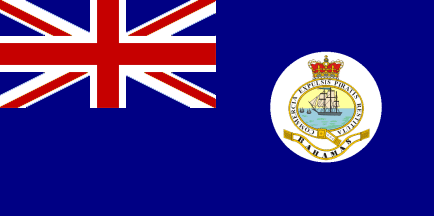
by Blas Delgado Ortiz, 9 September 2001

Last modified: 2005-04-16 by dov gutterman
Keywords: bahamas | colonial badge | crown | lighthouse | sombrero |
Links: FOTW homepage |
search |
disclaimer and copyright |
write us |
mirrors
See also:
The Bahamas badge was introduced in 1869 and changed little
before being discontinued in 1973. The crown in the Variants is not the pattern usually seen on flag
badges. Before 1904 it would probably have been an angular
flat topped crown; from 1904 to 1953 a more domed Tudor crown,
and after 1953 a St.Edward’s crown. Until 1964 the shape of
the badge, excluding crown and scroll, was horizontally oval, but
was then made more circular and larger, relative to the
ensign. On the Blue Ensign it was on a white disc until
1923.
Officially there was no Red Ensign, but many were in use
unofficially by the 1930s, and in 1962 the Port Director of
Nassau estimated that there were probably over 1,000 defaced Red
Ensigns being flown by yachts at the time, and that more than
5,000 yachts had the ensign, and would have flown it at some time
in the past. The Colonial Office wrote to the Bahamian
government: "We realise that the unauthorised wearing of the
defaced Red Ensign in both the Bahamas and Bermuda has become so
widespread that there seems no possibility of bringing about its
discontinuance without the creation of much ill-feeling, and do
not therefore intend taking action against those concerned.
On the other hand, the Board of Admiralty has again ruled that
the present misuse of the defaced Red Ensign cannot be
regularised." [Bahamian Symbols by Whitney Smith in
Flag Bulletin March-June 1976]
David Prothero, 2 August 2001

by Blas Delgado Ortiz, 9 September 2001
This flag has the Victorian Crown, which was used until about
1902, even though this crown was phased out since 1880. The crown
image is based on a drawing presented by Jarig Bakker and
following the colors of the other crowns at Jaume Olle's website.
Blas Delgado Ortiz, 9 September 2001
Bahamas used circular seal in garter in 1869 flag.
David Prothero, 8 April 2005
1869.gif)
by Blas Delgado Ortiz, 9 September 2001
A close up of the badge of this flag.
Blas Delgado Ortiz, 9 September 2001

by Blas Delgado Ortiz, 9 September 2001
The Victorian Crown was replaced by the Imperial or Tudor
Crown, introduced by King Edward VII around 1902.
Blas Delgado Ortiz, 9 September 2001
In some correspondence of 1919, when the Colonial Office had
to send out a questionnaire to ask colonial governors what their
flags looked like, were paintings of the flags of the Bahamas.
One, which was known as the Revenue Flag because it was used only
by Out-Island Commissioners who were Revenue Officers, was a Blue
Ensign defaced with an over-size (3/5ths breadth) crown, with
depressed arches. Behind the times I guess, rather than ahead of
them.
The reply to the Colonial Office was written by a W.Miller who
was Civil Engineer in the Bahamas, and deserves a mention as an
early vexi-maniac. Out of all the replies, must have been 30 odd,
he was the only one who sent back water-colour paintings of all
the flags in use in the colony, instead of a brief description.
David Prothero, 15 July 1997

by Blas Delgado Ortiz, 9 September 2001
The same badge but without the white circle.
Blas Delgado Ortiz, 9 September 2001

by Blas Delgado Ortiz, 9 September 2001
The Tudor Crown was replaced by the St. Edward Crown,
introduced by Queen Elizabeth II in 1953.
Blas Delgado Ortiz, 9 September 2001
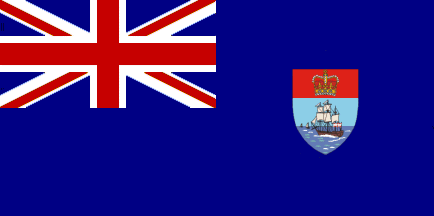
by Blas Delgado Ortiz, 9 September 2001
This flag is based on the badge presented by Jaume Olle' in
May 1997 (The Colonial Badge from 1959 to
Independence), but with the colors recently corrected (the
badge below is incorrect). He was not sure by then if it was
encircled or not. According to Nahum Shereshevsky, this badge
appeared probably in 1973, which makes more logic
Blas Delgado Ortiz, 9 September 2001

by Blas Delgado Ortiz, 9 September 2001
The new badge inside a white circle. Note that this badge is
more elaborated than the simpler one above because it presents
two scrolls: the one at the top with Bahamas inscribed in it, and
the one under with the motto.
Blas Delgado Ortiz, 9 September 2001

by Blas Delgado Ortiz, 9 September 2001
The same badge without the circle. Just an artistic exercise.
It may or may not have existed, owing to the fact of the
existence of the simpler version shown above (1959?).
Blas Delgado Ortiz, 9 September 2001
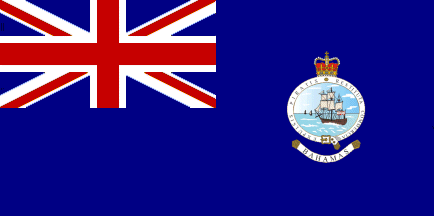
by Blas Delgado Ortiz, 9 September 2001
Based on Jaume's badge at his website. This flag appears at
Znamierowski's "The World Encyclopedia of Flags" [zna99] as 1964-1973 flag.
Blas Delgado Ortiz, 11 September 2000 and 9 September
2001

blue ensign
by Blas Delgado Ortiz, 2 August 2001
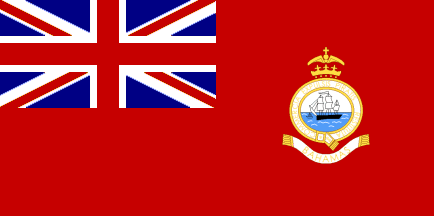
red ensign
by Blas Delgado Ortiz, 2 August 2001
col.gif)
Badges
by Blas Delgado Ortiz, 2 August 2001
Those images are based on photos
of a red ensign taken by Dov Gutterman at a flag display
in ICV 19 (York, July 2001). The origilal flag is from Bruce
Berry collection. According to the display catalouge:
"The moto redas: "With the expultion of the Pirates,
Commerece was restored". In the 17th and 18th centuries
pirates ravaged the Caribbean Sea."
These two versions may have been unofficial or their origins are
not clear.
Blas Delgado Ortiz and Dov Gutterman, 2 August
2001
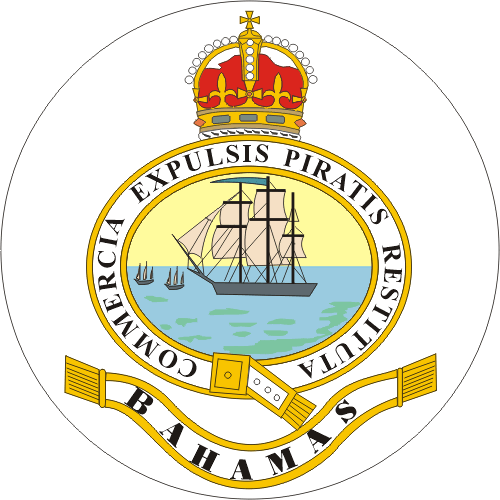
by Jaume Olle', 5 September 2001
For image from the National Geographic click here.
A large and two small ships within a garter surmounted by a
crown constitute the principal device of the badge of the
Bahamas. On the garter are words which tell us that the pirates
have been expelled and that business has been resumed.
This badge is the basis of the coat of arms
the country adopted on independence. They replaced the old Latin
motto with a much more anodyne one in English.
Roy Stilling, 19 February 1996
This is the colonial badge that was used on Bahama Blue ensign
in 1904-1955. It replaced old crown (1869-1904) and was replaced
with the new crown (1955-1964) and newer redention (1964-1973)
Jaume Olle', 5 September 2001
In 1959 a new shield was granted to Bahamas and the old badge
became obsolete. The new shield was included in the Blue Ensign
(I don't know if in a white circle or directly in the blue
field). Perhaps the same new shield was used in the Governor's
flag (Union Jack with circle with wreath in the centre?). Can you
confirm?
Jaume Olle', 4 May 1997
My stamp album suggests another year! The above shield appears
on a 1973 stamp issued for Bahama's independence so I assume that
it was granted then. Another stamp in the set shows the flag, but
as I didn't keep it I don't know what flag it is. The definitive
series of 1964 shows the older shield: it is divided horizontaly
red-white-green, the green is water on which there is a ship with
masts only (no sails). On the red stripe there is a royal crown.
The motto was changed from the Latin Commercia Expulsis
Piratis Restituta (Commerce restored on the defeat of the
pirates) to the English "Forward, upward, onward,
together". I use these two stamps in my exhibit to show how
the transition from colony to independent state is reflected in
the arms (especially the removal of the royal crown).
Nahum Shereshevsky, 7 May 1997
Overseas lighthouses were the responsibility of the Imperial
Lighthouse Service of the Board of Trade.
The Bahamas office looked after not only the lighthouses on the
Bahamas but also that on Sombrero, a small island that was part
of the St Christopher-Nevis group of the Leeward Islands.
The tender based at Nassau flew a Blue Ensign with a badge that
consisted of a lighthouse within an oval belt on which BOARD OF
TRADE was written in white on red. The belt was surmounted by a
crown, with a red scroll above, bearing the word BAHAMA in
white. This was an official flag warranted 20 July
1898. It was more usual for colonial lighthouse tenders to
fly the Board of Trade Blue Ensign with the sailing ship badge.
The Bahama/Sombrero badge was flown by the tender Ana Patricia
until about 1971 when it was replaced by the Board of Trade Blue
Ensign [Bahamian Symbols by Whitney Smith in The Flag Bulletin
XIV:2-3], but the lighthouse at Sombrero, on special occasions,
flew the Wheel and Anchor Blue Ensign of the Ministry of
Transport, which had taken over the Board of Trade's transport
responsibilities in, I think, the early 1950's [Public Record
Office document MT 45/580].
David Prothero, 18 November 2000